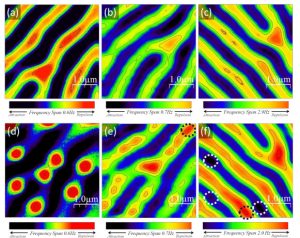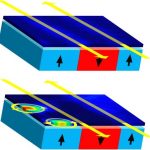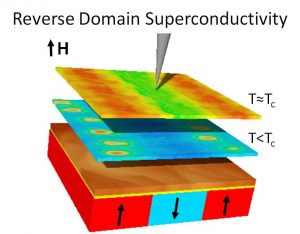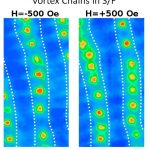Magnetically coupled planar ferromagnet-superconductor (F/S) hybrid structures offer new avenues for manipulation of the superconductivity at the nanoscale and convenient means to control vortex dynamics.
Observation of Vortex Clusters in Ferromagnet/Superconductor Heterostructures

MFM maps showing vortex configurations at the bifurcation.
While Abrikosov vortices repel each other, and form a uniform vortex lattice in bulk type-II superconductors, strong confinement potential profoundly affects their spatial distribution eventually leading to vortex cluster formation. The confinement could be induced by the geometric boundaries in mesoscopic-size superconductors or by the spatial modulation of the magnetic field in superconductor/ ferromagnet (S/F) hybrids.
Our findings suggest that special magnetic topologies could result in S/F hybrids that support superconductivity even when locally the vortex density exceeds the thermodynamic critical threshold value beyond which the superconductivity is destroyed. Sci. Rep. 6, 38557 (2016)
Doppler-STM Current Imaging Ferromagnet/Superconductor Systems

Doppler STM maps of the super-currents in Ferromagnet/Superconductor.
Low temperature scanning tunneling spectroscopy measurements reveal nano-scale mapping of the distribution of super-currents in a superconductor subject to a spatially inhomogeneous magnetic field. In ferromagnet/superconductor systems a spatially inhomogeneous magnetic stray field alters the local distribution of supercurrents. The Doppler shift on the quasiparticle excitation spectrum in the superconductor can be detected by low temperature scanning tunneling spectroscopy achieving direct imaging of the intricate super-current pattern in the superconductor. Appl. Phys. Lett. 108, 042601 (2016)
Controlling Nanoscale Superconductivity in Ferromagnet/Superconductor Systems

STM measurements taken at the surface of a F/S bilayer. The top image is the conductance map acquired just below the critical temperature in the presence of an applied magnetic field that compensates one type of magnetic domains of the ferromagnet. The middle image is the conductance map at the same location and in the same applied field at T=1.5 K. The bottom image is the topography of the superconducting layer. The cartoon shows the magnetic domains of the underlaying ferromagnetic layer.
The nonuniform magnetic field produced by the ferromagnet spatially confines superconductivity. When the temperature is decreased below Tc, the superconductivity is expected to nucleate first at the location where the stray field is minimum, i.e. at the domain wall, which is a realization of domain wall superconductivity. Therefore, the superconductivity is confined in tiny channels that can more or less interact depending upon the distance between them. When an external magnetic field is applied the superconducting nuclei will shift to the center of the compensated domain (reverse domain superconductivity). Furthermore, by reversing the polarity of the applied field there will be a switching of a normal region in superconducting and viceversa.
These results demonstrate that such F/S structures are attractive model systems that offer the possibility to control the strength and the location of the superconducting nuclei by applying an external magnetic field. Nature Communications 5, 4766 (2014)
Influence of Domain Width on Vortex Nucleation in Ferromagnet/Superconductor Systems

Vortex Chains of opposite polarities localized above the ferromagnetic domain of the same polarity.
In of S/F systems vortices form chain structures above the magnetic domains with same polarity as the applied field and they are confined to move along the channels determined by the underlying magnetic landscape of the ferromagnet. Journal of Superconductivity and Novel Magnetism
